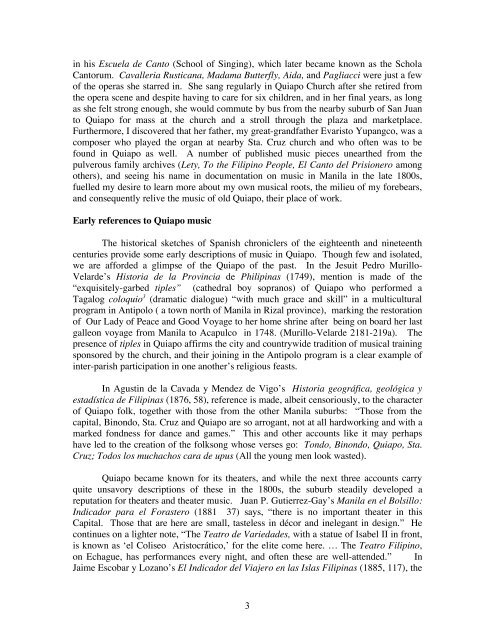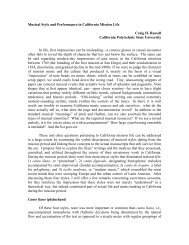Music in The Heart of Manila - Center for Iberian and Latin American ...
Music in The Heart of Manila - Center for Iberian and Latin American ...
Music in The Heart of Manila - Center for Iberian and Latin American ...
Create successful ePaper yourself
Turn your PDF publications into a flip-book with our unique Google optimized e-Paper software.
<strong>in</strong> his Escuela de Canto (School <strong>of</strong> S<strong>in</strong>g<strong>in</strong>g), which later became known as the Schola<br />
Cantorum. Cavalleria Rusticana, Madama Butterfly, Aida, <strong>and</strong> Pagliacci were just a few<br />
<strong>of</strong> the operas she starred <strong>in</strong>. She sang regularly <strong>in</strong> Quiapo Church after she retired from<br />
the opera scene <strong>and</strong> despite hav<strong>in</strong>g to care <strong>for</strong> six children, <strong>and</strong> <strong>in</strong> her f<strong>in</strong>al years, as long<br />
as she felt strong enough, she would commute by bus from the nearby suburb <strong>of</strong> San Juan<br />
to Quiapo <strong>for</strong> mass at the church <strong>and</strong> a stroll through the plaza <strong>and</strong> marketplace.<br />
Furthermore, I discovered that her father, my great-gr<strong>and</strong>father Evaristo Yupangco, was a<br />
composer who played the organ at nearby Sta. Cruz church <strong>and</strong> who <strong>of</strong>ten was to be<br />
found <strong>in</strong> Quiapo as well. A number <strong>of</strong> published music pieces unearthed from the<br />
pulverous family archives (Lety, To the Filip<strong>in</strong>o People, El Canto del Prisionero among<br />
others), <strong>and</strong> see<strong>in</strong>g his name <strong>in</strong> documentation on music <strong>in</strong> <strong>Manila</strong> <strong>in</strong> the late 1800s,<br />
fuelled my desire to learn more about my own musical roots, the milieu <strong>of</strong> my <strong>for</strong>ebears,<br />
<strong>and</strong> consequently relive the music <strong>of</strong> old Quiapo, their place <strong>of</strong> work.<br />
Early references to Quiapo music<br />
<strong>The</strong> historical sketches <strong>of</strong> Spanish chroniclers <strong>of</strong> the eighteenth <strong>and</strong> n<strong>in</strong>eteenth<br />
centuries provide some early descriptions <strong>of</strong> music <strong>in</strong> Quiapo. Though few <strong>and</strong> isolated,<br />
we are af<strong>for</strong>ded a glimpse <strong>of</strong> the Quiapo <strong>of</strong> the past. In the Jesuit Pedro Murillo-<br />
Velarde’s Historia de la Prov<strong>in</strong>cia de Philip<strong>in</strong>as (1749), mention is made <strong>of</strong> the<br />
“exquisitely-garbed tiples” (cathedral boy sopranos) <strong>of</strong> Quiapo who per<strong>for</strong>med a<br />
Tagalog coloquio 3 (dramatic dialogue) “with much grace <strong>and</strong> skill” <strong>in</strong> a multicultural<br />
program <strong>in</strong> Antipolo ( a town north <strong>of</strong> <strong>Manila</strong> <strong>in</strong> Rizal prov<strong>in</strong>ce), mark<strong>in</strong>g the restoration<br />
<strong>of</strong> Our Lady <strong>of</strong> Peace <strong>and</strong> Good Voyage to her home shr<strong>in</strong>e after be<strong>in</strong>g on board her last<br />
galleon voyage from <strong>Manila</strong> to Acapulco <strong>in</strong> 1748. (Murillo-Velarde 2181-219a). <strong>The</strong><br />
presence <strong>of</strong> tiples <strong>in</strong> Quiapo affirms the city <strong>and</strong> countrywide tradition <strong>of</strong> musical tra<strong>in</strong><strong>in</strong>g<br />
sponsored by the church, <strong>and</strong> their jo<strong>in</strong><strong>in</strong>g <strong>in</strong> the Antipolo program is a clear example <strong>of</strong><br />
<strong>in</strong>ter-parish participation <strong>in</strong> one another’s religious feasts.<br />
In Agust<strong>in</strong> de la Cavada y Mendez de Vigo’s Historia geográfica, geológica y<br />
estadística de Filip<strong>in</strong>as (1876, 58), reference is made, albeit censoriously, to the character<br />
<strong>of</strong> Quiapo folk, together with those from the other <strong>Manila</strong> suburbs: “Those from the<br />
capital, B<strong>in</strong>ondo, Sta. Cruz <strong>and</strong> Quiapo are so arrogant, not at all hardwork<strong>in</strong>g <strong>and</strong> with a<br />
marked fondness <strong>for</strong> dance <strong>and</strong> games.” This <strong>and</strong> other accounts like it may perhaps<br />
have led to the creation <strong>of</strong> the folksong whose verses go: Tondo, B<strong>in</strong>ondo, Quiapo, Sta.<br />
Cruz; Todos los muchachos cara de upus (All the young men look wasted).<br />
Quiapo became known <strong>for</strong> its theaters, <strong>and</strong> while the next three accounts carry<br />
quite unsavory descriptions <strong>of</strong> these <strong>in</strong> the 1800s, the suburb steadily developed a<br />
reputation <strong>for</strong> theaters <strong>and</strong> theater music. Juan P. Gutierrez-Gay’s <strong>Manila</strong> en el Bolsillo:<br />
Indicador para el Forastero (1881 37) says, “there is no important theater <strong>in</strong> this<br />
Capital. Those that are here are small, tasteless <strong>in</strong> décor <strong>and</strong> <strong>in</strong>elegant <strong>in</strong> design.” He<br />
cont<strong>in</strong>ues on a lighter note, “<strong>The</strong> Teatro de Variedades, with a statue <strong>of</strong> Isabel II <strong>in</strong> front,<br />
is known as ‘el Coliseo Aristocrático,’ <strong>for</strong> the elite come here. … <strong>The</strong> Teatro Filip<strong>in</strong>o,<br />
on Echague, has per<strong>for</strong>mances every night, <strong>and</strong> <strong>of</strong>ten these are well-attended.” In<br />
Jaime Escobar y Lozano’s El Indicador del Viajero en las Islas Filip<strong>in</strong>as (1885, 117), the<br />
3




